|
DAY 2. MONDAY, AUGUST 12, 2002
Most of us were up by 6:30, and sleepily packing up our gear while sipping on
our coffee from the neat traveling mugs that OARS provided for us. This is a
tradition with OARS and Dories. Breakfast of eggs, toast, sausage and fruit
was served at 8:30, and we were on our way down the Colorado by 9:45.
After a short run we came to Boulder Narrows. We get an idea of the power of
the Colorado at flood stage in the days before Glen Canyon Dam was built by
looking at the driftwood lying on top of the boulder. This driftwood has
remained there ever since the flow of the river has been modified by the
controlled release from the dam. It is impressive.
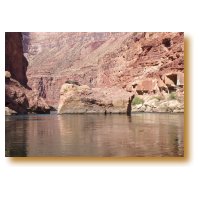
|
Driftwood on Boulder at Boulder Narrows
|
Shortly after passing through the narrows we arrived at North Canyon at mile
20.5. It was 10:15 am. The North Canyon hike is an easy half-mile or so up
the canyon to the lovely, crystal clear pools that lie in narrow, smooth
walled pockets or bowls in the red Supai. Bill told me that some of the
younger guys had tried to walk around the upper pool by using toeholds in the
sides of the bowls. This had resulted in some impromptu swimming, and
laughter and fun
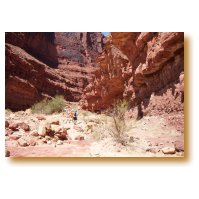
|
Hikers entering North Canyon
|
Although the hike up to the pools is an easy one, my vertigo has progressed
to the point where, even using two Leki Sticks I was having such a difficult
time keeping my footing that I turned back at the first incline. I could
have made it, but I would have been a hold up for the rest of the group, and
since I have been to North Canyon twice before I decided to hike back down to
the beach. Kevin and Jennifer, of course, had a great time.
With temperatures close to 100 degrees in the side canyons the North Canyon
hikers easily worked up a sweat on their way back from the pools. A brief dip
in the river cooled off some of smarter hikers.
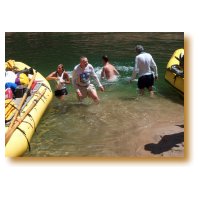
|
From left: Boat Swamper Robin Zindell, Bill Huggins, Steve Truitt and Michael
Sher.
|
After the swim we took a very short run down to a beach on our left at mile
23, where we stopped for lunch.
Cruising downstream after lunch the first obvious structure that got our
attention was the a pinnacle of red rock in the upper Supai on our right that
goes by the name of "Long Indian Dick." The adjacent rapid was known as
"Indian Dick Rapid" ever since it was given this name by a couple of river
guide geologists, George C. (Black George) Simmons and Parkman (Perky) Brooks
back in 1955. On their first trip in Marble Canyon, not being familiar with
the water, they flipped in the rapid below the now famous rock formation. In
the process of swimming to shore and righting their boat they had plenty of
time to look at, and comment on the prominent Supai pinnacle. They named it
on the spot. Simmons included it in his next book, "River Runner's Guide to
the Canyons of the Green and Colorado Rivers with Emphasis on Geological
Features: Marble Gorge and Grand Canyon." As Nancy Brian has said on page 26
in her publication, "River to Rim," no doubt with a chuckle, "Rumors that
this stone tower is named after an Indian named Richard who kept lonely
ladies company while their boy friends and husbands were working on the river
can now be dispelled."
"Indian Dick" was still the official name in the third edition of Larry
Steven's book, "The Colorado River in Grand Canyon, A Guide" that was the
Guide was used when Bill, Phil and I rafted with OARS from Bright Angel Creek
to Whitmore Wash in 1993. By the time of the publication of the 5th edition,
which we used on our trip with Dories from Lees Ferry to Bright Angel Creek
in 1997, the name had been changed to "23 and Half Mile Rapid." Apparently
the U.S. Government authorities determined that "Long Indian Dick" was not
politically correct.
Scotty Stevens tells us that the original name has since been restored. Thank
goodness. Scotty has suggested that the name should be "Tall Anasazi
Richard," but (thankfully) so far his suggestion has fallen on deaf ears.
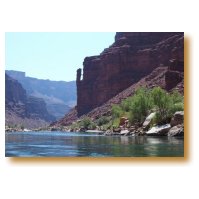
|
Long Indian Dick
|
Our smart remarks about the famous Supai phallus were soon cut short, and we
almost missed noticing the fact that the layer of Redwall Limestone appeared
here, because we were entering the "Roaring Twenties." In rapid succession
we ran Indian Dick, 23 ½ Mile (the real one) 24 Mile, 24 ½ Mile, 25 Mile
(Hansbrough-Richards) Cave Springs, Tiger Wash, MNA Rapids, and finally 29
Mile Rapid. That was 9 rapids, with soaking wet dunkings in 5 ½ miles of
river running. No wonder we froze to death when we did this on a cold, rainy
day with Dories 5 years ago. On our present trip, during a cloudless, hot
and sunny day, the dunkings were welcome.
There followed a mile and a half of pleasantly calm water as we drifted down
to the beaches of South Canyon with their Anasazi ruins and ancient
petroglyphs on the right
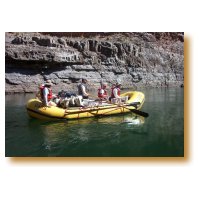
|
Boatman Matt Fahy gently rowing his boat. Larry and Kevin Roberts in the
stern. Bill and Jennifer Huggins in the bow.
|
Without stopping to look at the petroglyphs or the ruins, or stopping to
climb up to Stanton's Cave, a disappointment to me, we gently cruised around
the bend past Vasey's Paradise on the right. John Wesley Powell was so
impressed with the greenery and colorful blossoms made possible my springs in
the Supai cliff that he named the place Vasey's Paradise, in honor of George
W. Vasey, a physician and botanist, who had accompanied Powell on his
exploration of the Rockies in the summer of 1868. Of this area Powell wrote,
"The river turns sharply to the east and seems enclosed by a wall set with a
million brilliant gems. …On coming nearer we find fountains bursting from the
rock high overhead, and spray in the sunshine forms gems which bedeck the
wall. Rocks below the fountain are covered with mosses and ferns and many
beautiful flowering plants." It is a pretty site, but not quite that pretty.
Powell was a very good writer, but at times he tended to hyperbolize.
Nancy Brian tells us that in the Redwall Limestone solution caves above
spelunkers have found 2 ½ miles of passageways. Care must be taken in
climbing up to these caves as the rocks here are covered with poison ivy.
A mile beyond Vasey's Paradise we came to the Redwall Cavern. This is a huge
cavern that has been cut into the rock cliff at river level by the sand and
gravel slurry-like water
of the pre Glen Canyon Dam days when the force of flood currents scowered it
out. Powell called it "…a vast half-circular chamber, which, if utilized for
a theater, would give sitting to 50,000 people." He noted that at high water
"…the floor is covered with a raging flood." This is another example of
Powell's propensity to dramatize in his reports.
There is no doubt that the cavern is huge, but when you think about a
structure the size of the Rupp Arena in Lexington, Kentucky with a seating
capacity of 20,000, and notice how much larger it is than the Redwall Cavern,
you get the idea. I wonder if Powell would have stretched his dimensions so
this much if he had thought about the fact that someday so many others would
view the river as he did. Robert Stanton, who originally had idolized Powell,
upon studying Powell's publications in light of his, Stanton's, own
explorations of the Canyon, later came to view him as an ordinary man who had
strengths and weaknesses like all of the rest of us.
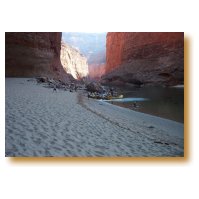
|
On our 1997 trip with Dories, using a plastic bat and ball, we were able to
play softball in this cavern. Camping is not allowed in the Cavern.
|
Exploring the Redwall Cavern to everyone's satisfaction took about an hour of
the afternoon. As we boarded our boats I noticed that the hearing aid for my
right ear was not in the little water proof plastic bag where I had kept it
along with my camera. I guess it was lost somewhere in the frequent
unwrapping and wrapping of the camera required to protect it from our
frequent dunkings during our run through the "Roaring Twenties." It was no
great loss, because I had a couple of spares with me, but it was frustrating.
From Redwall Cavern we had a leisurely cruise down tranquil waters, appearing
to get ever deeper into the Redwall Limestone layer. The illusion of rapidly
entering a deep abyss is created by the fact that the level of the cliffs
above is rising by 75 feet a mile. Therefor, even though the river is
descending only 8 feet a mile, the rafts are being swept into a much deeper
canyon than would be expected at this gradient.
Because of its compact, smooth appearance, Powell had originally thought that
this layer was marble, and that is why he named this part of the canyon
"Marble Canyon." Actually this densely packed limestone and dolomite
(magnesium bearing limestone) was deposited in a shallow sea during the
Mississippian Period approximately 335 million years ago. It forms a massive
cliff from 540 feet thick in the east to 700 feet in the west. Fossils of
sponges, sea lilies, brachiopods, corals, and nautiloids (both straight and
coiled) have been found in this layer. The deep red color has been caused by
iron oxide stains that have leached down from the Supai and Hermit Shale
above. The true color of the so-called Redwall, according to Larry Stevens,
is ivory with black dolomite bands. Personally, I have not seen the ivory
color, but have seen plenty of the dark dolomite in places where segments of
the superficial red stained layer has chipped off.
We arrived at Nautiloid Canyon around 4:00 O'clock, which gave us plenty of
time to set up camp leisurely, and shoot the breeze with each other. Dinner
was baked salmon, salad and broccoli along with lots of other dishes that I
don't remember except that they were all good.
Shooting stars provided a pleasant display in the sky during the night.
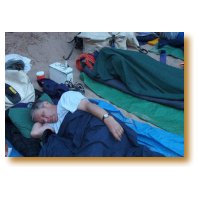
|
Phil is comfortably asleep. His son, Larry is in the next sleeping bag to the
right.
|
|